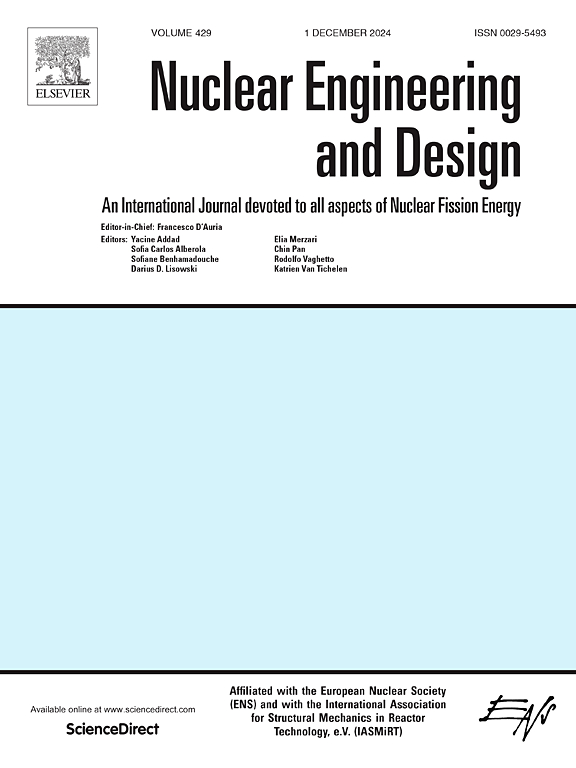倾斜u形管内气液两相流动的实验研究
IF 2.1
3区 工程技术
Q1 NUCLEAR SCIENCE & TECHNOLOGY
引用次数: 0
摘要
相对于对水平定向u型管内气液两相流动的广泛研究,对倾斜u型管内流动特性的研究相对有限。实验设计包括获取整个上下倾斜管道配置的流态数据和压力测量。系统地记录了不同倾斜角下的流动模式,随后分析了不同倾斜角对压力损失的影响,同时考虑了不同的流动模式、雷诺数和管径。通过流型摄影的实验可视化显示,三种不同的流型——分层塞塞流、塞塞泡流和段塞波流——对倾角的变化具有显著的敏感性。相反,环波流和环散流对这种角度变化的敏感性相对较小。流型图表明,重力驱动流型对应的区域及其过渡边界随着倾角的变化而发生明显的变化。相反,主要由惯性力控制的流型在类似条件下变化不大。不同流型下,倾角对压力损失的影响不同。随着气液表面雷诺数的增加,倾角对压力损失的影响更为明显。此外,与大直径管道相比,小直径管道的压力损失对倾角变化的敏感性更高。本文章由计算机程序翻译,如有差异,请以英文原文为准。
Experimental research on gas-liquid two-phase flow in inclined U-tubes
In contrast to the extensive research on gas-liquid two-phase flow within horizontally oriented U-tubes, investigations into the flow characteristics within inclined U-tubes remain relatively limited. The experimental design encompassed the acquisition of flow pattern data and pressure measurements across the entire spectrum of upward and downward inclined pipe configurations. Flow patterns were systematically documented at varying inclination angles, with subsequent analysis focusing on the impact of different angles on pressure loss, considering diverse flow patterns, Reynolds numbers, and pipe diameters at the same time. Experimental visualization through flow pattern photography revealed that three distinct flow patterns—stratified-plug flow, plug-bubble flow, and slug-wavy flow—exhibit significant sensitivity to variations in inclination angle. Conversely, annular-wavy flow and annular-dispersed flow demonstrate comparatively less susceptibility to such angular changes. The flow pattern maps illustrate that regions corresponding to gravity-driven flow patterns and their transitional boundaries undergo notable modifications with alterations in the inclination angle. In contrast, flow patterns governed primarily by inertial forces show minor variation under similar conditions. The effect of inclination angle on pressure loss varies under different flow patterns. Specifically, the influence of inclination angle on pressure loss becomes more pronounced with increasing gas-liquid superficial Reynolds numbers. Furthermore, the pressure loss in smaller-diameter pipelines exhibits higher sensitivity to inclination angle variations than their larger-diameter counterparts.
求助全文
通过发布文献求助,成功后即可免费获取论文全文。
去求助
来源期刊

Nuclear Engineering and Design
工程技术-核科学技术
CiteScore
3.40
自引率
11.80%
发文量
377
审稿时长
5 months
期刊介绍:
Nuclear Engineering and Design covers the wide range of disciplines involved in the engineering, design, safety and construction of nuclear fission reactors. The Editors welcome papers both on applied and innovative aspects and developments in nuclear science and technology.
Fundamentals of Reactor Design include:
• Thermal-Hydraulics and Core Physics
• Safety Analysis, Risk Assessment (PSA)
• Structural and Mechanical Engineering
• Materials Science
• Fuel Behavior and Design
• Structural Plant Design
• Engineering of Reactor Components
• Experiments
Aspects beyond fundamentals of Reactor Design covered:
• Accident Mitigation Measures
• Reactor Control Systems
• Licensing Issues
• Safeguard Engineering
• Economy of Plants
• Reprocessing / Waste Disposal
• Applications of Nuclear Energy
• Maintenance
• Decommissioning
Papers on new reactor ideas and developments (Generation IV reactors) such as inherently safe modular HTRs, High Performance LWRs/HWRs and LMFBs/GFR will be considered; Actinide Burners, Accelerator Driven Systems, Energy Amplifiers and other special designs of power and research reactors and their applications are also encouraged.
 求助内容:
求助内容: 应助结果提醒方式:
应助结果提醒方式:


